2013.5 Peugeot 308 CC tow bar
[x] Cancel search: tow barPage 131 of 268
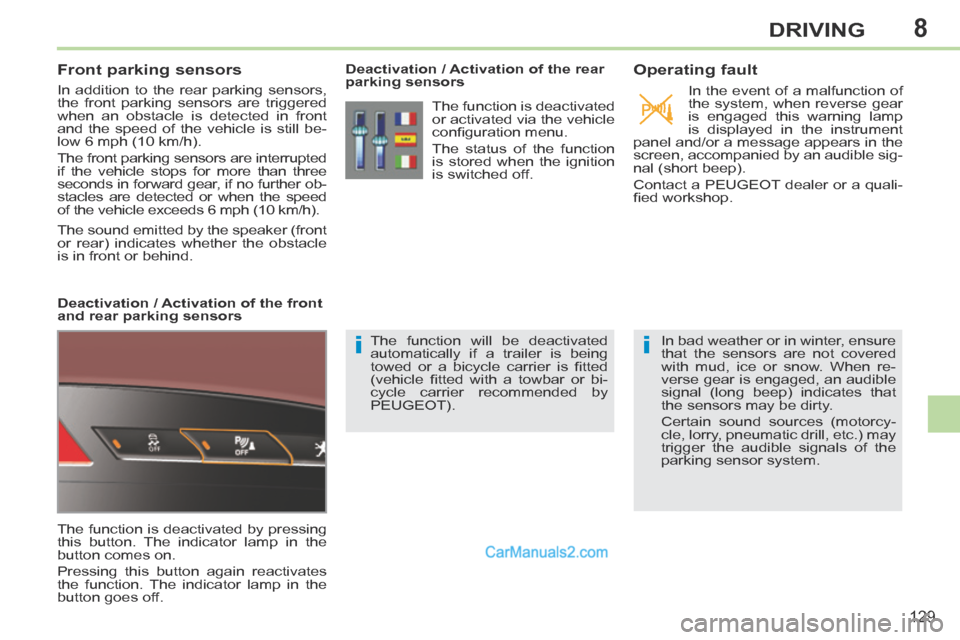
8
ii
129
DRIVING
Front parking sensors
In addition to the rear parking sensors,
the front parking sensors are triggered
when an obstacle is detected in front
and the speed of the vehicle is still be-
low 6 mph (10 km/h).
The front parking sensors are interrupted
if the vehicle stops for more than three
seconds in forward gear, if no further ob-
stacles are detected or when the speed
of the vehicle exceeds 6 mph (10 km/h).
The sound emitted by the speaker (front
or rear) indicates whether the obstacle
is in front or behind.
The function is deactivated by pressing
this button. The indicator lamp in the
button comes on.
Pressing this button again reactivates
the function. The indicator lamp in the
button goes off. Deactivation / Activation of the rear
parking sensors
The function will be deactivated
automatically if a trailer is being
towed or a bicycle carrier is fi tted
(vehicle fi tted with a towbar or bi-
cycle carrier recommended by
PEUGEOT).
Operating fault
In the event of a malfunction of
the system, when reverse gear
is engaged this warning lamp
is displayed in the instrument
panel and/or a message appears in the
screen, accompanied by an audible sig-
nal (short beep).
Contact a PEUGEOT dealer or a quali-
fi ed workshop.
In bad weather or in winter, ensure
that the sensors are not covered
with mud, ice or snow. When re-
verse gear is engaged, an audible
signal (long beep) indicates that
the sensors may be dirty.
Certain sound sources (motorcy-
cle, lorry, pneumatic drill, etc.) may
trigger the audible signals of the
parking sensor system.
The function is deactivated
or activated via the vehicle
confi guration menu.
The status of the function
is stored when the ignition
is switched off.
Deactivation / Activation of the front
and rear parking sensors
Page 142 of 268
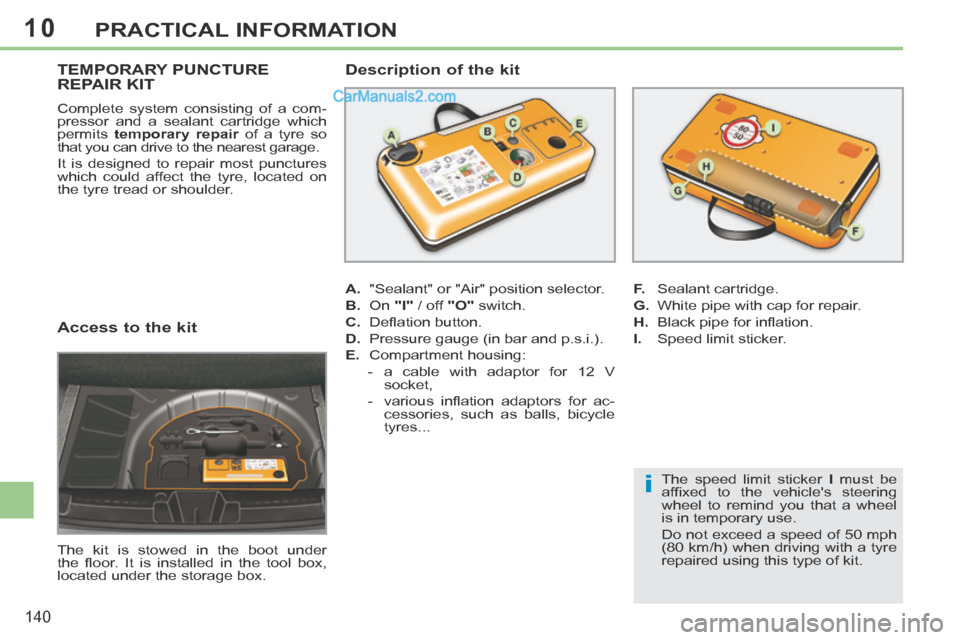
10
i
140
PRACTICAL INFORMATION
Access to the kit
The kit is stowed in the boot under
the fl oor. It is installed in the tool box,
located under the storage box.
TEMPORARY PUNCTURE REPAIR KIT
A. "Sealant" or "Air" position selector.
B. On "I" / off "O" switch.
C. Defl ation button.
D. Pressure gauge (in bar and p.s.i.).
E. Compartment housing: - a cable with adaptor for 12 V socket,
- various infl ation adaptors for ac- cessories, such as balls, bicycle
tyres...
Description of the kit
F. Sealant cartridge.
G. White pipe with cap for repair.
H. Black pipe for infl ation.
I. Speed limit sticker.
The speed limit sticker I must be
affi xed to the vehicle's steering
wheel to remind you that a wheel
is in temporary use.
Do not exceed a speed of 50 mph
(80 km/h) when driving with a tyre
repaired using this type of kit.
Complete system consisting of a com-
pressor and a sealant cartridge which
permits
temporary repair of a tyre so
that you can drive to the nearest garage.
It is designed to repair most punctures
which could affect the tyre, located on
the tyre tread or shoulder.
Page 167 of 268
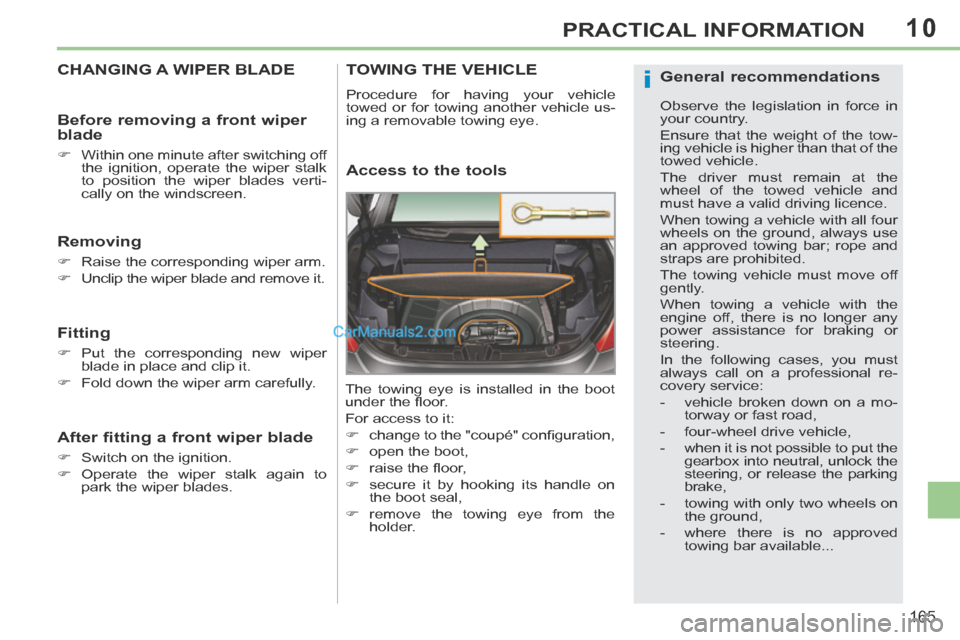
10
i
165
PRACTICAL INFORMATION
CHANGING A WIPER BLADE
Removing
Raise the corresponding wiper arm.
Unclip the wiper blade and remove it.
Fitting
Put the corresponding new wiper blade in place and clip it.
Fold down the wiper arm carefully.
Before removing a front wiper
blade
Within one minute after switching off the ignition, operate the wiper stalk
to position the wiper blades verti-
cally on the windscreen.
After fitting a front wiper blade
Switch on the ignition.
Operate the wiper stalk again to park the wiper blades.
TOWING THE VEHICLE
Procedure for having your vehicle
towed or for towing another vehicle us-
ing a removable towing eye.
Access to the tools
The towing eye is installed in the boot
under the fl oor.
For access to it:
change to the "coupé" confi guration,
open the boot,
raise the fl oor,
secure it by hooking its handle on the boot seal,
remove the towing eye from the holder.
General recommendations
Observe the legislation in force in
your country.
Ensure that the weight of the tow-
ing vehicle is higher than that of the
towed vehicle.
The driver must remain at the
wheel of the towed vehicle and
must have a valid driving licence.
When towing a vehicle with all four
wheels on the ground, always use
an approved towing bar; rope and
straps are prohibited.
The towing vehicle must move off
gently.
When towing a vehicle with the
engine off, there is no longer any
power assistance for braking or
steering.
In the following cases, you must
a lways call on a professional re-
covery service:
- vehicle broken down on a mo-torway or fast road,
- four-wheel drive vehicle,
- when it is not possible to put the gearbox into neutral, unlock the
steering, or release the parking
brake,
- towing with only two wheels on the ground,
- where there is no approved towing bar available...
Page 168 of 268
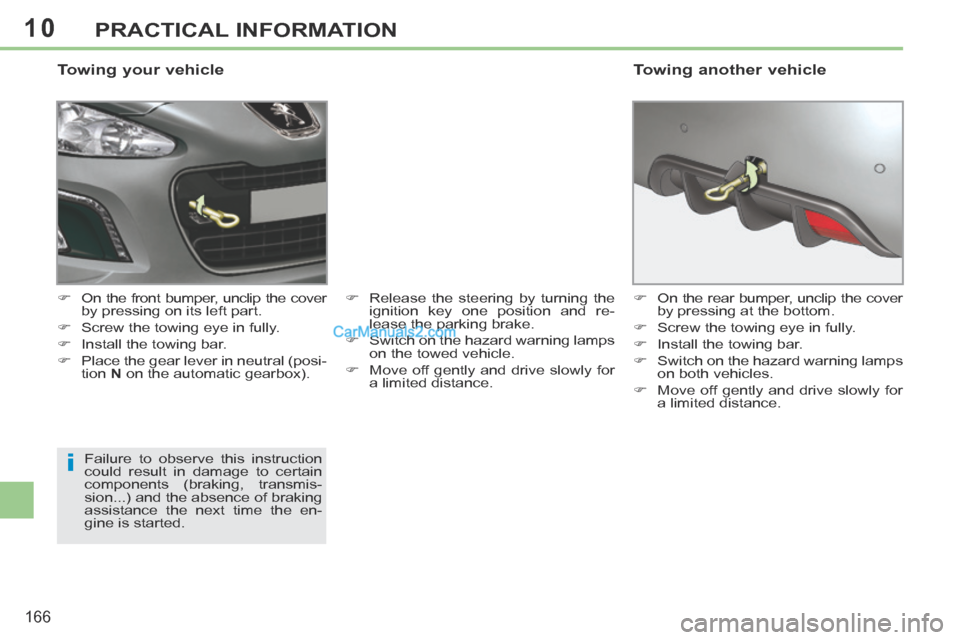
10
i
166
PRACTICAL INFORMATION
Towing your vehicle
On the front bumper, unclip the cover by pressing on its left part.
Screw the towing eye in fully.
Install the towing bar.
Place the gear lever in neutral (posi- tion N on the automatic gearbox). Release the steering by turning the
ignition key one position and re-
lease the parking brake.
Switch on the hazard warning lamps on the towed vehicle.
Move off gently and drive slowly for a limited distance.
Failure to observe this instruction
could result in damage to certain
components (braking, transmis-
sion...) and the absence of braking
assistance the next time the en-
gine is started. On the rear bumper, unclip the cover
by pressing at the bottom.
Screw the towing eye in fully.
Install the towing bar.
Switch on the hazard warning lamps on both vehicles.
Move off gently and drive slowly for a limited distance.
Towing another vehicle
Page 169 of 268
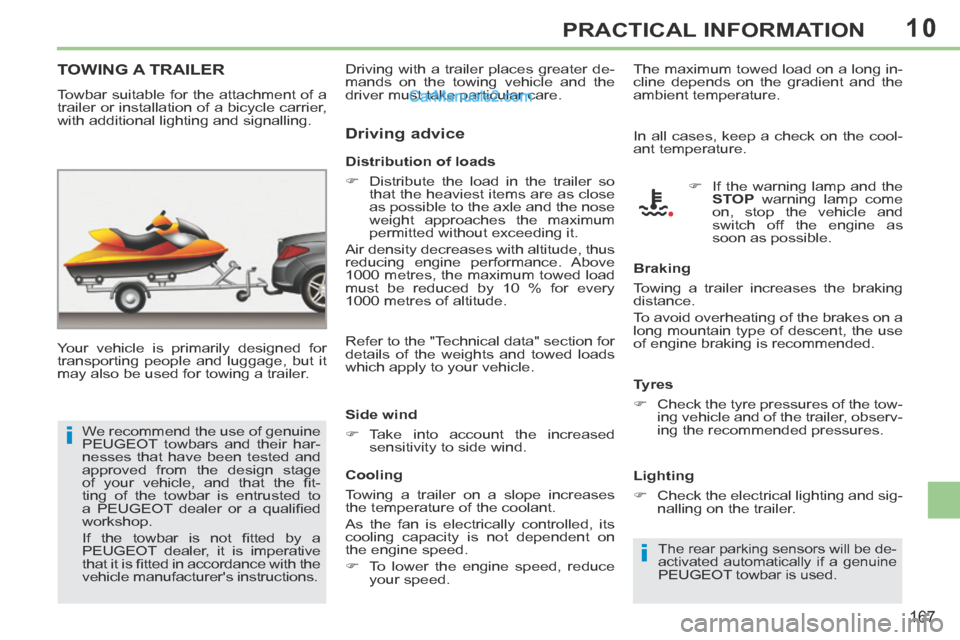
10
i
i
167
PRACTICAL INFORMATION
TOWING A TRAILER
Your vehicle is primarily designed for
transporting people and luggage, but it
may also be used for towing a trailer. Distribution of loads
Distribute the load in the trailer so
that the heaviest items are as close
as possible to the axle and the nose
weight approaches the maximum
permitted without exceeding it.
Air density decreases with altitude, thus
reducing engine performance. Above
1000 metres, the maximum towed load
must be reduced by 10 % for every
1000 metres of altitude.
Refer to the "Technical data" section for
details of the weights and towed loads
which apply to your vehicle.
Side wind
Take into account the increased sensitivity to side wind.
Towbar suitable for the attachment of a
trailer or installation of a bicycle carrier,
with additional lighting and signalling.
Driving advice
We recommend the use of genuine
PEUGEOT towbars and their har-
nesses that have been tested and
approved from the design stage
of your vehicle, and that the fi t-
ting of the towbar is entrusted to
a PEUGEOT dealer or a qualifi ed
workshop.
If the towbar is not fi tted by a
PEUGEOT dealer, it is imperative
that it is fi tted in accordance with the
vehicle manufacturer's instructions. Driving with a trailer places greater de-
mands on the towing vehicle and the
driver must take particular care.
In all cases, keep a check on the cool-
ant temperature.
Braking
Towing a trailer increases the braking
distance.
To avoid overheating of the brakes on a
long mountain type of descent, the use
of engine braking is recommended.
Tyres
Check the tyre pressures of the tow-ing vehicle and of the trailer, observ-
ing the recommended pressures.
Lighting
Check the electrical lighting and sig- nalling on the trailer.
The rear parking sensors will be de-
activated automatically if a genuine
PEUGEOT towbar is used.
If the warning lamp and the STOP warning lamp come
on, stop the vehicle and
switch off the engine as
soon as possible.
The maximum towed load on a long in-
cline depends on the gradient and the
ambient temperature.
Cooling
Towing a trailer on a slope increases
the temperature of the coolant.
As the fan is electrically controlled, its
cooling capacity is not dependent on
the engine speed.
To lower the engine speed, reduce your speed.
Page 170 of 268
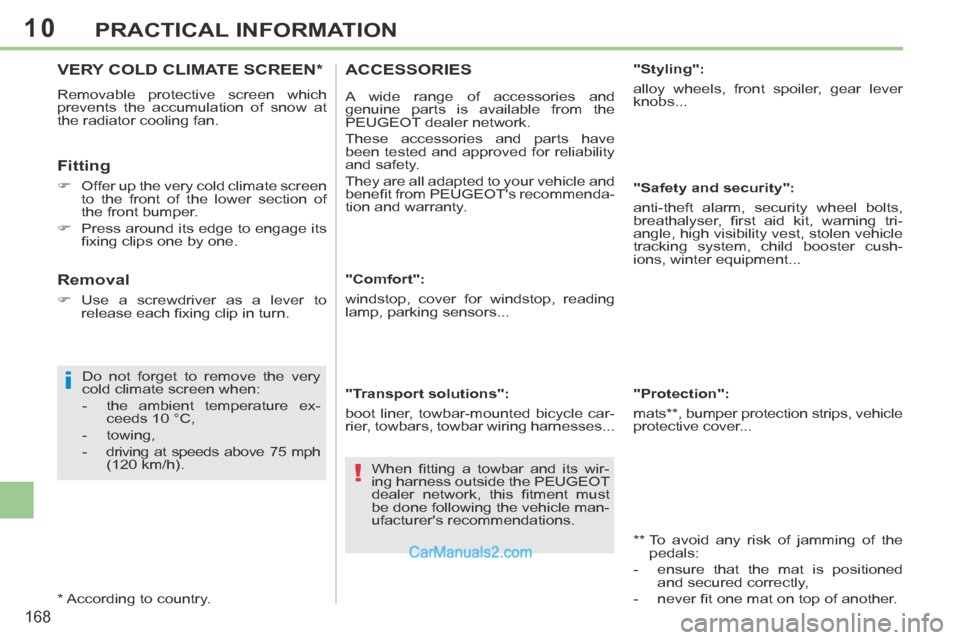
10
i
!
168
PRACTICAL INFORMATION
VERY COLD CLIMATE SCREEN *
Removable protective screen which
prevents the accumulation of snow at
the radiator cooling fan.
Fitting
Offer up the very cold climate screen to the front of the lower section of
the front bumper.
Press around its edge to engage its fi xing clips one by one.
Do not forget to remove the very
cold climate screen when:
- the ambient temperature ex- ceeds 10 °C,
- towing,
- driving at speeds above 75 mph (120 km/h).
* According to country.
Removal
Use a screwdriver as a lever to release each fi xing clip in turn. "Comfort":
windstop, cover for windstop, reading
lamp, parking sensors...
"Transport solutions":
boot liner, towbar-mounted bicycle car-
rier, towbars, towbar wiring harnesses...
ACCESSORIES
A wide range of accessories and
genuine parts is available from the
PEUGEOT dealer network.
These accessories and parts have
been tested and approved for reliability
and safety.
They are all adapted to your vehicle and
benefi t from PEUGEOT's recommenda-
tion and warranty. "Styling":
alloy wheels, front spoiler, gear lever
knobs...
"Safety and security":
anti-theft alarm, security wheel bolts,
breathalyser, fi rst aid kit, warning tri-
angle, high visibility vest, stolen vehicle
tracking system, child booster cush-
ions, winter equipment...
** To avoid any risk of jamming of the
pedals:
- ensure that the mat is positioned and secured correctly,
- never fi t one mat on top of another.
"Protection":
mats ** , bumper protection strips, vehicle
protective cover...
When fi tting a towbar and its wir-
ing harness outside the PEUGEOT
dealer network, this fi tment must
be done following the vehicle man-
ufacturer's recommendations.
Page 254 of 268
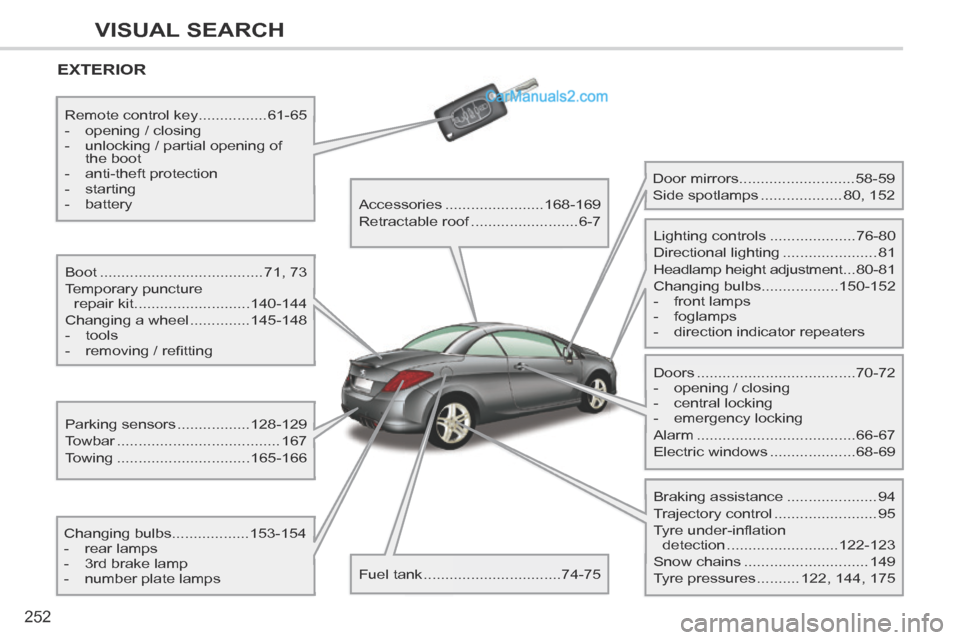
252
VISUAL SEARCH
EXTERIOR
Boot ......................................71, 73
Temporary puncture repair kit ........................... 140-144
Changing a wheel .............. 145-148
- tools
- removing / refi tting
Changing bulbs ..................153-154
- rear lamps
- 3rd brake lamp
- number plate lamps Parking sensors .................
128-129
Towbar ...................................... 167
Towing ............................... 165-166
Remote control key
................61-65
- opening / closing
- unlocking / partial opening of the boot
- anti-theft protection
- starting
- battery Accessories .......................168-169
Retractable roof ......................... 6-7
Fuel tank ................................ 74-75 Door mirrors ...........................
58-59
Side spotlamps ................... 80, 152
Doors ..................................... 70-72
- opening / closing
- central locking
- emergency locking
Alarm ..................................... 66-67
Electric windows .................... 68-69
Lighting controls ....................
76-80
Directional lighting ...................... 81
Headlamp height adjustment ... 80-81
Changing bulbs ..................150-152
- front lamps
- foglamps
- direction indicator repeaters
Braking assistance ..................... 94
Trajectory control ........................ 95
Tyre under-inflation detection .......................... 122-123
Snow chains ............................. 149
Tyre pressures .......... 122, 144, 175
Page 255 of 268

253
VISUAL SEARCH
INTERIOR
Boot fittings ............................91-92
- stowing rings
- luggage retaining net
- luggage retaining strap
- storage net
- storage box
Installing the windstop ........... 50-52
Child seats .................
104-109, 113
ISOFIX child seats ............. 110-112
Rear seats .................................. 57 Front seats
............................. 52-57
"AIRWAVE" systems ................... 56
Seat belts ............................... 97-99 Airbags ..............................
100-103
Interior fiftings ........................
86-90
- lockable glove box
- mat
- lockable front armrest
Roll-over bars ............................. 96
Deactivating the passenger's
front airbag ..................... 101, 105